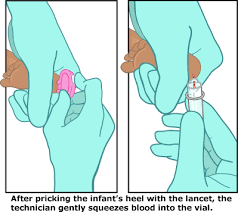Which of the following is an appropriate technique for specimen collection?
Performing a heel stick on a 5-year-old patient
Performing a finger stick on a toddler patient
Performing a thumb stick on an infant
Performing a thumb stick on a 5-year-old patient
The Correct Answer is B
Choice A reason:
Performing a heel stick on a 5-year-old patient is not an appropriate technique. Heel sticks are typically used for infants, particularly newborns, to minimize discomfort and because their finger pads may not be fully developed for finger sticks. By the age of 5, a child's veins are usually developed enough for venipuncture, which is the preferred method.
Choice B reason:
Performing a finger stick on a toddler patient is an appropriate technique for specimen collection. This method is commonly used for children who are not yet old enough for venipuncture but have outgrown the heel stick method. The finger stick is performed on the palmar surface of the distal phalanx, usually of the middle or ring finger, and is considered safe and effective for collecting small blood samples in toddlers.
Choice C reason:
Performing a thumb stick on an infant is not an appropriate technique. The thumb has a pulse and is more sensitive, which can cause unnecessary pain and distress to the infant. Additionally, the thumb's size and increased movement make it a less suitable site for specimen collection in infants.
Choice D reason:
Performing a thumb stick on a 5-year-old patient is also not an appropriate technique. As with infants, the thumb's sensitivity and the presence of a pulse make it a less desirable site for blood collection. For a 5-year-old, venipuncture or a finger stick on a non-thumb finger would be more appropriate and less distressing.

Nursing Test Bank
Naxlex Comprehensive Predictor Exams
Related Questions
Correct Answer is C
Explanation
Choice A Reason:
Sterile water is not an antiseptic; it does not contain antimicrobial agents. While it can be used to rinse a site, it will not disinfect the area before a venipuncture procedure. Therefore, it is not an appropriate substitute for alcohol in this context.
Choice B Reason:
Antiseptic foam may contain alcohol or other disinfectants. If it is alcohol-free, it could be a suitable alternative. However, without specific information about the ingredients, it cannot be assumed to be an appropriate choice for a patient allergic to alcohol.
Choice C Reason:
Chlorhexidine is a commonly used antiseptic for skin preparation before medical procedures, including venipuncture. It is effective against a broad spectrum of bacteria and is an appropriate alternative for patients who have an allergy to alcohol-based antiseptics.
Choice D Reason:
Saline solution is not an antiseptic. It is a sterile solution of sodium chloride in water and does not have antimicrobial properties. Like sterile water, it is not suitable for disinfecting the venipuncture site.
Correct Answer is C
Explanation
Choice A Reason:
Shaking the tubes vigorously can cause hemolysis, which is the rupture of red blood cells, leading to inaccurate test results. It is not recommended as it does not provide gentle mixing and can damage the blood cells.
Choice B Reason:
Moving the tubes in a figure-eight motion is not a standard practice for mixing blood samples. This method may not provide the consistent and gentle inversion needed to mix the anticoagulant with the blood effectively.
Choice C Reason:
Rolling the tubes between the palms of the hands 4 to 8 times after collection is the recommended method. This technique allows for gentle and thorough mixing of the blood with the anticoagulant, preventing clotting without causing hemolysis. The number of inversions ensures that the anticoagulant coats the inner surface of the tube and mixes with the blood, which is essential for accurate laboratory results.
Choice D Reason:
Passing the tubes from hand to hand is not an effective method for mixing blood samples. This action may not provide the necessary inversion and can lead to inadequate mixing, resulting in clotted specimens.
Whether you are a student looking to ace your exams or a practicing nurse seeking to enhance your expertise , our nursing education contents will empower you with the confidence and competence to make a difference in the lives of patients and become a respected leader in the healthcare field.
Visit Naxlex, invest in your future and unlock endless possibilities with our unparalleled nursing education contents today
Report Wrong Answer on the Current Question
Do you disagree with the answer? If yes, what is your expected answer? Explain.
Kindly be descriptive with the issue you are facing.
